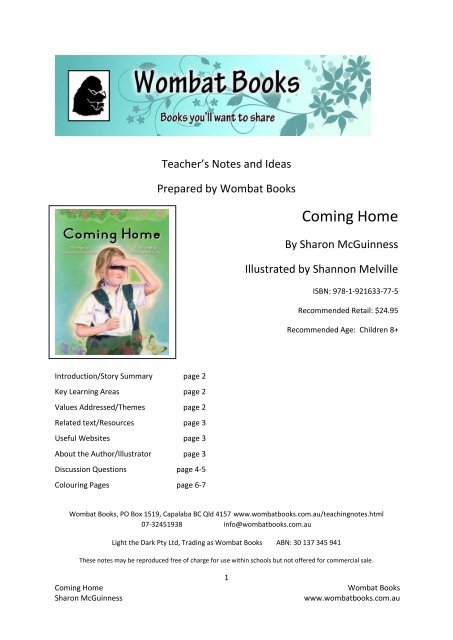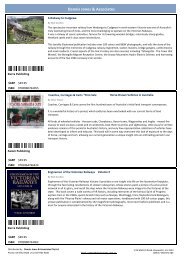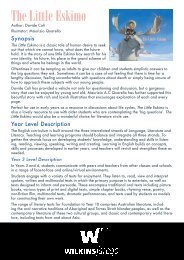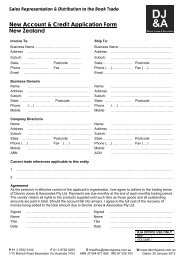Coming Home - Dennis Jones & Associates
Coming Home - Dennis Jones & Associates
Coming Home - Dennis Jones & Associates
- No tags were found...
Create successful ePaper yourself
Turn your PDF publications into a flip-book with our unique Google optimized e-Paper software.
Teacher’s Notes and IdeasPrepared by Wombat Books<strong>Coming</strong> <strong>Home</strong>By Sharon McGuinnessIllustrated by Shannon MelvilleISBN: 978-1-921633-77-5Recommended Retail: $24.95Recommended Age: Children 8+Introduction/Story Summary page 2Key Learning Areas page 2Values Addressed/Themes page 2Related text/Resources page 3Useful Websites page 3About the Author/Illustrator page 3Discussion Questions page 4-5Colouring Pages page 6-7Wombat Books, PO Box 1519, Capalaba BC Qld 4157 www.wombatbooks.com.au/teachingnotes.html07-32451938 info@wombatbooks.com.auLight the Dark Pty Ltd, Trading as Wombat Books ABN: 30 137 345 941These notes may be reproduced free of charge for use within schools but not offered for commercial sale.<strong>Coming</strong> <strong>Home</strong>Sharon McGuinness1Wombat Bookswww.wombatbooks.com.au
IntroductionGemma doesn’t understand why her father doesn’t want to play with her anymore. All he does is sitin the garden – he seems sad all the time.Gemma’s father suffers from a depressive illness – we aren’t told why, so it could be for a number ofreasons – from a specific event, a chemical imbalance in the brain or even due to the onset ofwinter. The story follows Gemma as she tries to understand her father’s illness, which occurs overtime – signified in the story by the changing of the seasons. The story shows how a depressive illnessaffects members of the family, particularly children, who often find it more difficult to understand.<strong>Coming</strong> <strong>Home</strong> focuses on hope, as Gemma’s father recovers eventually.The illustrations mirror the journey Gemma’s father endures, beginning with black and whiteendpapers of the weeded garden and closing with the final endpapers of a garden in flower, burstingwith colour.<strong>Coming</strong> <strong>Home</strong> is suitable to be shared with upper primary students in years 5 and 6 and also usefulfor secondary students in years 7-10 studying PDHPE.Story SummaryGemma watches her dad as he sits alone in the garden, she doesn’t understand why he seems sad allthe time and doesn’t want to play with her anymore. She questions whether she has donesomething wrong to make him feel this way. Gemma seeks answers from her mother, who reassuresher; informing Gemma that her dad suffers from an illness called depression, which may not be asvisible as other illnesses. At her mother’s urging, Gemma tries to engage her father in her interests,but he again disappears into his ‘other place’. One day, however, as the sun begins to warm his back,Gemma’s dad begins to feel different and we know that his depression has begun to lift.<strong>Coming</strong> <strong>Home</strong> tells a story common to one in five families where someone experiences such anillness. The story is hopeful and even though Gemma’s dad is ill, he does get better over time. Hedoes find his way home.Shannon Melville’s illustrations convey the father’s mood at the beginning of the book, in the use oflimited black and white shades. Symbols of a tangled, unkempt garden are also used to convey herfather’s state of mind. As he recovers, colour begins to creep onto the pages, ending with a unitedfather and daughter and images of a flowering, weedless garden.Key Learning AreasEnglish (Australian National Curriculum Foundation to Yr 10)Visual LiteracyPDHPE (NSW Curriculum Stages 4 & 5)Values Addressed/ThemesFamily RelationshipsDepression<strong>Coming</strong> <strong>Home</strong>Sharon McGuinness2Wombat Bookswww.wombatbooks.com.au
Related Text/ResourcesTan, Shaun The Red TreeMiller, David Big and MeNikolin, Tara The Shadow on the Wall www.blurb.com/books/3269437Useful WebsitesBlack Dog Institute fact sheets on depressionwww.blackdoginstitute.org.au/factsheets/index.cfm#factDepressionBlack Dog is a centre for research, education , advice and consultation. The fact sheets are suitablefor students in Years 7 and above.Youth Beyond Blue www.youthbeyondblue.com/factsheets-and-infoDesigned for a teenage audience, this site provides information of specific interest to young peopleHeadspace www.headspace.org.au This National Youth Mental Health Foundation helps youngpeople undergoing difficulties in their lives. There are fact sheets and information on the site andalso details regarding where to locate a headspace centre or how to access the 24hr eheadspaceservice.RUOK www.ruokday.com.au/content/home.aspx This initiative is held annually on September 15and encourages people to ask ‘RUOK?’ instead of ‘How are you?’ which may illicit the automaticresponse of ‘Good’, even though the person may not really be feeling that way. The site encouragespeople to start a conversation with someone you feel may be experiencing a mental health issue.Site suitable for secondary students.About the Author – Sharon McGuinnessSharon McGuinness works as a teacher librarian in a primary school onthe south coast of New South Wales and writes picture books and juniornovels for children. After writing her first ‘book’ in year six for a schoolassignment, Sharon has been writing ever since. She has had two storiespublished in the New South Wales School Magazine and her first ebookTry! was published in March, 2012. Apart from writing and teaching,Sharon is kept busy with her two teenage children and mischievousborder collie, Buster.About the Illustrator – Shannon MelvilleShannon is a freelance illustrator, graphic designer and community artteacher from Perth. She has illustrated the following books: My ArmsYour Legs (Blake Education) by Kim Rackham, Matilda’s MorningAdventures and Choose Active Transport: A Teacher’s Resource (PhysicalActivity Taskforce, 2010) by Kim Chute, and Little Good Wolf (WombatBooks, 2011) by Aleesah Darlison.<strong>Coming</strong> <strong>Home</strong> is the fifth book she has illustrated and she particularlyenjoyed working in pastels.When she is not working Shannon loves walking with her husband,Ninian, Dora explorer Jaya, and sheep rounder Hugo.<strong>Coming</strong> <strong>Home</strong>Sharon McGuinness3Wombat Bookswww.wombatbooks.com.au
Discussion Questions1. After reading the first few pages of <strong>Coming</strong> <strong>Home</strong>, what were your first thoughts aboutGemma’s dad?2. What do you think Gemma was feeling when she looked at her Dad sitting in the garden?3. What did Gemma’s mum mean when she explained the father’s illness as ‘something youcan’t see’?4. Can depression be visible? How do you know Gemma’s dad is depressed by reading the text?5. Gemma refers to her dad being in ‘that other place’. What does she mean by this?6. What is the significance of the title <strong>Coming</strong> <strong>Home</strong>?7. Why do you think the author used symbols of plants and a garden extensively throughoutthe book?8. What feelings do the author and illustrator leave you with at the end of the story?9. What things make your students happy? Students may even draw their responses. Ask themwhat they think has helped Gemma’s dad begin to feel happier.Discussion Questions – Visual Literacy1. Look at each of the beginning and final endpapers. How do these symbolise the beginningand ending of the story?2. Why has the illustrator used black and white illustrations?3. Why do you think the illustrator has coloured some aspects of the illustrations on most ofthe pages?4. Look at the illustration featuring the father reaching out to the warm sunshine. What doesthis represent?5. What does the wilted rose symbolise?6. How does the text and illustrations work together to tell the story?7. What is it that the father sees in the garden, trying to reach the sunlight?Discussion Questions – PDHPE (Secondary Students)1. What are the main symptoms of depression? (use the fact sheets on the Black Dog Institutesite)2. Which symptoms do you recognise in Gemma’s father?3. Depression can be referred to as an invisible illness. How true do you think this statement isin relation to the story and characters?4. What are some of the reasons for depression?5. Which, if any, can you recognise within the story?6. Why is depression sometimes referred to as an ‘episode’?7. What are some useful ways to help someone through an episode of depression?8. What do you see as evidence of support for Gemma’s father in the book?9. How have the author and illustrator combined to tell both a story and information aboutdepression?10. Discuss with your students the differences between sadness and depression.<strong>Coming</strong> <strong>Home</strong>Sharon McGuinness4Wombat Bookswww.wombatbooks.com.au
11. Using the recommended websites, ask students to research suggested ways to relieve andprevent depression.12. What things do the students do that make them happy?13. Find specific web pages from the sites provided that would be helpful for teenagersexperiencing depression.14. Design your own ecard and send it to someone you know who is experiencing depression.You may be inspired by some examples on the Black Dog site:www.blackdoginstitute.org.au/public/gettinghelp/ecards.cfm15. Encourage students to enter the annual Black Dog photographic competition or hold yourown to raise awareness and promote resilience. See:www.blackdoginstitute.org.au/public/events/photocompetition.cfmClassroom Activities - Upper Primary Students1. Students could develop a Reader’s Theatre script and perform in front of the class.2. Using students’ own drawings or images of weeds and gardens collected via Flickr CreativeCommons, design a book trailer for <strong>Coming</strong> <strong>Home</strong>. Teachers and students have theillustrator’s permission to use the illustrations provided on these pages. Send the best trailerto the author via the website www.mrsmacsbooks.weebly.com3. Design a postcard and send it to someone the students care about. In it, instead of asking‘How are you’, use ‘Are U OK’ instead. The Black Dog site has a page with a selection ofecards teachers could use as examples.4. Using ‘Storybird’ ( www.storybird.com ) students could work on a collaborative story with aclassmate. One person starts the story and it is sent to another who continues the storybefore returning it to the first person, etc. It could focus on how students can help someonefeel better if they have been sad lately. What things could students do to make them feelbetter? Use the illustrations on the site for inspiration.5. Based on the idea above, students could also write their own story and publish it as anebook using a combination of power point and movie maker software. Instructions can befound here: www.youtube.com/watch?v=bJ9es0KEA6I&feature=plcp6. As an art activity, students could use the endpapers as inspiration, and create their ownversion. These could also be scanned and used in book trailers.7. Colour plays a key role in the illustrations of <strong>Coming</strong> <strong>Home</strong>. It also has a role in the two keyorganisations that assist people who experience depression – Black Dog and Beyond Blue.Ask students what is ‘blue’ to them? This could also lend itself to an art activity.<strong>Coming</strong> <strong>Home</strong>Sharon McGuinness5Wombat Bookswww.wombatbooks.com.au
<strong>Coming</strong> <strong>Home</strong>Sharon McGuinness6Wombat Bookswww.wombatbooks.com.au
<strong>Coming</strong> <strong>Home</strong>Sharon McGuinness7Wombat Bookswww.wombatbooks.com.au





